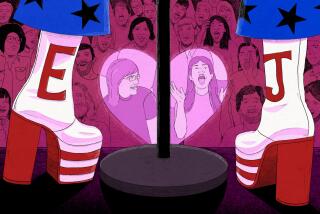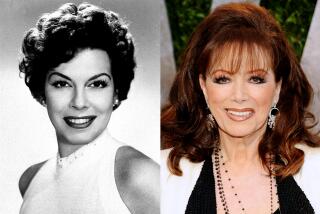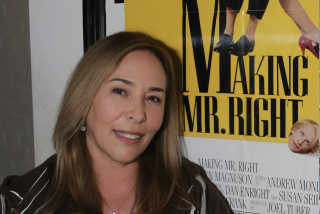Strong-Willed Women Behind ‘Seeking Susan’
- Share via
Sexual politics being what they are in Hollywood, a film with two women producers, a woman director, a woman writer and two female lead characters wasn’t destined to be an easy sale.
“Our standard joke was that if the film ever got made, no one would be left to see it because everyone had read the screenplay,” said Midge Sanford, producer with Sarah Pillsbury of “Desperately Seeking Susan.”
The screenplay, as it turns out, has been revised so many times since Sanford and Pillsbury optioned it four years ago that familiarity isn’t a worry. But a funny thing happened while the movie was in production: Madonna, cast in the pivotal role of Susan, became a teen icon of come-hither sexuality.
For better or worse, “Desperately Seeking Susan” became The Madonna Movie, threatening to alienate the very audience--adult women--that the film had been conceived for.
“We feel it’s important to tell people that this is about two women and not a Madonna film,” Sanford said in an interview last week. “Forgetting who Madonna is, the Susan character represents freedom and living one’s life in a liberated fashion, in contrast to the repressed Roberta (Rosanna Arquette).”
Not that Madonna’s performance was in any way lacking; the producers were pleasantly surprised (as have been most critics). But they don’t want people to be “disappointed,” said Pillsbury, “that they’re not seeing ‘Purple Rain,’ or ‘Pink Rain.’ ”
“Pink Rain” is exactly what moviegoers might expect after a look at the “Desperately” trailer, video or TV ads. All use Madonna as an obvious lure for teen moviegoers. The producers were far happier with the print ad, which shows Madonna and Arquette equally.
Leora Barish’s original script for “Desperately Seeking Susan” was a rather cerebral character study of a 30ish woman. While mid-level women studio executives loved the film, their male bosses were less enthusiastic. The project eventually found a home at Warner Bros. But while Warners was submitting lists of recommended stars--Goldie Hawn, Cher, Diane Keaton--Pillsbury, Sanford and director Susan Seidelman were deciding that the project would be much fresher with a younger lead character.
Warners and the producers parted ways in January, 1984. The project found a new home at Orion Pictures, largely through the efforts of Senior Vice President Barbara Boyle.
The script went through additional drafts incorporating more romance, more jeopardy and more visual elements. Adding what Sanford calls “so many plot elements to satisfy the different people who had to be satisfied” made for a great deal of friction during filming. Arquette has publicly criticized Seidelman in interviews; screenwriter Barish, the producers acknowledge, was disappointed with some of the changes. Said Sanford, diplomatically: “There were a lot of strong-willed women involved.”
“The main thing we learned is that a good movie isn’t necessarily a movie made by one big happy family,” Pillsbury said.
“That’s a problem for women,” Sanford added. “It’s easier for them to think that they’ll all get along and somehow things will work out. Fortunately, we’re all still talking.”
Although Pillsbury and Sanford are both well connected--Sanford’s husband is literary agent Geoffrey Sanford, and Pillsbury is of the Minnesota Pillsbury (flour) clan--both worked their way up the ladder, Pillsbury winning a 1980 Oscar for her American Film Institute short “Board and Care.” They funded their company in 1982 with $500,000 in limited partnership funds raised in Minnesota.
Their next project is “Eight Men Out,” to be directed by John Sayles from his screenplay about the 1919 Black Sox scandal. Emilio Estevez has agreed to appear. Pillsbury and Sanford are financing the $5-million project independently but plan on studio distribution.
More to Read
Only good movies
Get the Indie Focus newsletter, Mark Olsen's weekly guide to the world of cinema.
You may occasionally receive promotional content from the Los Angeles Times.









